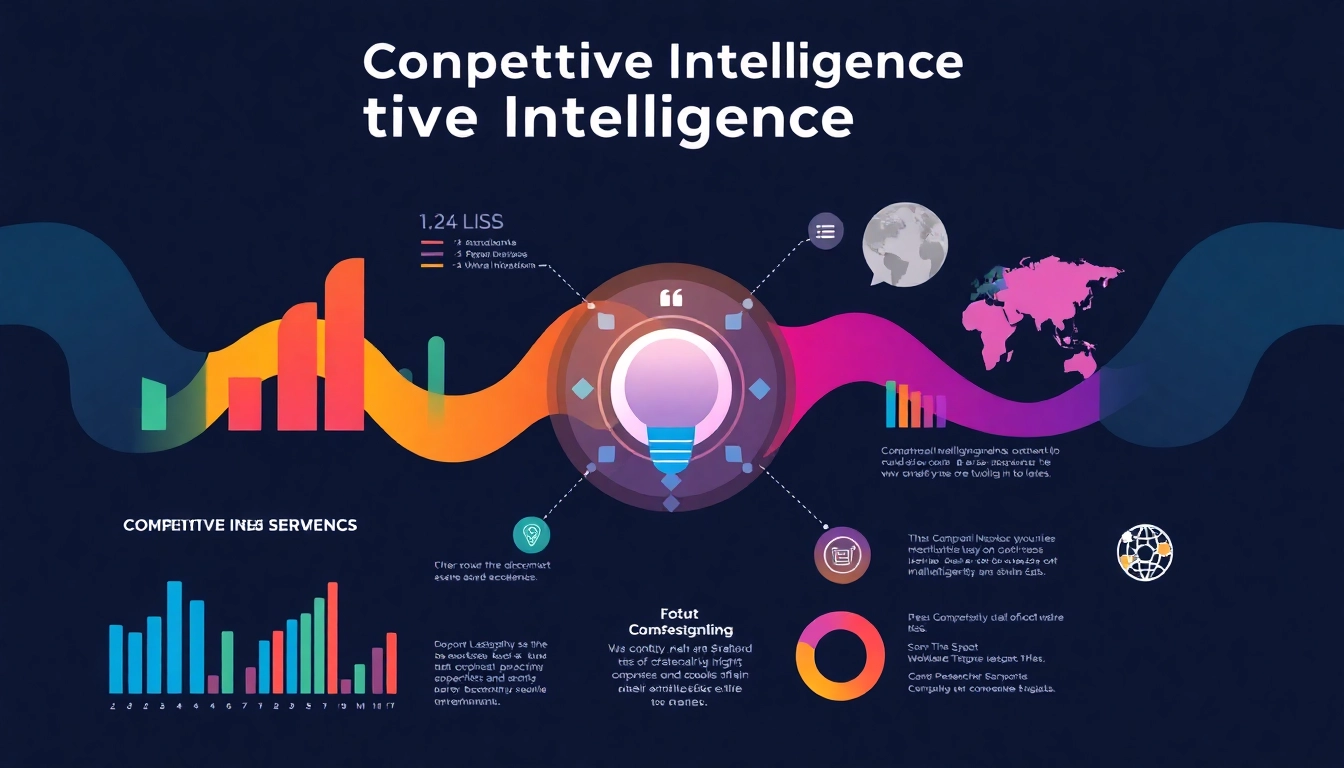Understanding Competitive Intelligence
Definition and Importance
Competitive intelligence (CI) refers to the structured processes for gathering, analyzing, and utilizing information about competitors and the market environment to inform strategic business decisions. It encompasses not only direct information on competitors’ actions but also broader insights into market trends, customer preferences, and potential disruptions within the industry. In today’s fast-paced, data-driven world, leveraging competitive intelligence services is paramount for organizations aiming to maintain an edge and foster sustainable growth.
In essence, competitive intelligence empowers organizations to anticipate market shifts, identify opportunities for innovation, and mitigate risks. By systematically analyzing competitor data and market dynamics, businesses can enhance their marketing strategies, refine their product offerings, and improve overall strategic positioning.
Types of Competitive Intelligence
Competitive intelligence can be categorized into several types, each serving distinct roles in the strategic decision-making process:
- Market Intelligence: This involves the collection of information regarding market trends and customer behavior, helping businesses anticipate shifts in demand and preferences.
- Competitor Intelligence: This type focuses on analyzing competitors, including their strengths, weaknesses, strategies, and performance metrics, to identify areas for differentiation and improvement.
- Product Intelligence: This involves gathering insights on competitors’ product features, pricing strategies, and innovations. Understanding these elements can guide businesses in enhancing their own offerings.
- Customer Intelligence: By understanding customer preferences and behaviors, organizations can tailor their marketing strategies to better meet the needs of their target audience.
- Industry Intelligence: Monitoring broader industry trends, regulatory changes, and technological advancements helps businesses adapt proactively to external factors that may impact their operations.
Legal and Ethical Considerations
While gathering competitive intelligence is essential for business success, it’s crucial to adhere to legal and ethical standards. Unlike industrial espionage, which is illegal and unethical, competitive intelligence aims to gather insights through publicly available information, industry reports, and legitimate means of data collection.
Organizations must be mindful of the laws surrounding data privacy, intellectual property, and fair competition. Establishing a code of ethics for competitive intelligence practices can help mitigate risks and foster trust with stakeholders.
Key Components of Competitive Intelligence Services
Data Collection Techniques
Effective data collection is the cornerstone of robust competitive intelligence. The following techniques are commonly employed:
- Online Research: Utilizing search engines, news articles, trade publications, and social media can provide insights into competitors’ activities and industry trends.
- Surveys and Interviews: Engaging current and former customers, suppliers, and industry experts can yield qualitative data that adds depth to quantitative findings.
- Market Reports and Databases: Subscribing to industry reports and databases enables access to comprehensive data sets and analyses conducted by experts.
- Networking: Attending industry conferences, webinars, and events can provide firsthand insights through discussions with peers and competitors.
Analysis Methods Overview
Once data is collected, the analysis phase transforms raw information into actionable insights. Common methods include:
- SWOT Analysis: This framework assesses the strengths, weaknesses, opportunities, and threats regarding competitors, helping organizations identify strategic advantages.
- PEST Analysis: Evaluating political, economic, social, and technological factors provides a macro perspective on market conditions and potential disruptions.
- Benchmarking: Comparing key performance indicators (KPIs) against competitors helps highlight areas where a business may excel or lag.
- Trend Analysis: Identifying patterns within collected data can help in forecasting future market developments and customer behaviors.
Reporting and Implementation Strategies
Effective reporting and implementation of findings are critical to realizing the benefits of competitive intelligence. Organizations should focus on creating clear, visually appealing reports that summarize insights and recommendations. Key elements include:
- Executive Summaries: Brief overviews that highlight the most critical insights for decision-makers.
- Visualization Tools: Using dashboards, charts, and graphs can help convey complex data in an understandable manner.
- Action Plans: Detailing specific strategies and steps that businesses can take based on gathered intelligence ensures that insights translate into practice.
Challenges in Competitive Intelligence
Common Misconceptions
Several misconceptions can hinder effective competitive intelligence practices, including:
- CI is Just About Competitors: While understanding competition is vital, CI also encompasses market dynamics, consumer behavior, and industry trends.
- CI is Only for Large Companies: Businesses of all sizes can benefit from competitive intelligence, as even small insights can drive significant strategic advantages.
- CI is Illegal or Unethical: When conducted properly, competitive intelligence adheres to legal and ethical standards and differentiates itself from espionage.
Data Privacy and Compliance Issues
As data privacy regulations such as GDPR and CCPA become increasingly stringent, organizations must be cautious in their data collection methods. Ensuring compliance will not only protect businesses from legal repercussions but also build trust with customers.
Strategies to Overcome Challenges
To overcome challenges in competitive intelligence, businesses should consider the following strategies:
- Invest in Training: Providing employees with the knowledge and tools necessary for effective CI will bolster data collection and analysis efforts.
- Establish Clear Guidelines: Developing a CI framework and ethical guidelines can ensure that efforts remain compliant and focused.
- Utilize Technology: Employing CI tools and software can streamline data collection and analysis processes, increasing efficiency and accuracy.
Case Studies: Success Through Competitive Intelligence
Industry-Specific Examples
Several organizations have successfully leveraged competitive intelligence to enhance their market positioning:
- Technology Sector: A leading tech firm utilized competitive intelligence to assess competitors’ product roadmaps, leading to the successful launch of an innovative software solution ahead of competitors.
- Retail Sector: A popular retail chain employed customer intelligence to identify consumer buying patterns, allowing for targeted marketing campaigns that increased foot traffic by 30% in six months.
- Pharmaceutical Sector: A major pharmaceutical company adopted competitive intelligence to track competitor drug launches and clinical trials, allowing them to align their R&D efforts effectively.
Quantifiable Benefits Realized
The quantifiable benefits of implementing robust competitive intelligence services can be significant:
- Increased revenue growth through market opportunities identified via competitive insights.
- Cost reductions achieved by refining operational strategies based on competitor analysis.
- Enhanced customer satisfaction and retention through targeted marketing initiatives driven by consumer insights.
Lessons Learned and Best Practices
Successful implementation of competitive intelligence provides valuable lessons:
- Continuous Learning: The competitive landscape is dynamic; organizations must continuously adapt their CI efforts based on new insights.
- Collaboration Across Departments: Engaging multiple departments (marketing, sales, R&D) ensures that CI insights are integrated into all aspects of decision-making.
- Focus on Quality Over Quantity: Prioritizing high-quality, relevant insights over sheer volume of data leads to more informed decision-making.
Choosing the Right Competitive Intelligence Services
Key Factors to Consider
When selecting a competitive intelligence service provider, organizations should consider several factors:
- Expertise: Evaluate the provider’s experience and knowledge in your specific industry or market.
- Technology: Assess whether the provider utilizes advanced technologies for data collection and analysis.
- Reputation: Look for client testimonials and case studies that demonstrate the provider’s ability to deliver value.
Evaluating Service Providers
The evaluation process should involve comprehensive due diligence, including:
- Requesting demos or trial periods to assess the effectiveness of the CI tools.
- Inquiring about the methodologies used for data collection and analysis.
- Understanding their approach to compliance and ethical standards in competitive intelligence practices.
Future Trends in Competitive Intelligence
As the landscape of competitive intelligence continues to evolve, several trends are emerging:
- Artificial Intelligence and Machine Learning: Many organizations are leveraging AI tools to enhance data collection and predictive analytics capabilities.
- Real-time Insights: The demand for immediate insights is growing, leading to the need for tools that provide real-time analytics.
- Integration of Big Data: Combining traditional CI methods with big data analytics will enable deeper insights and more comprehensive market understanding.



